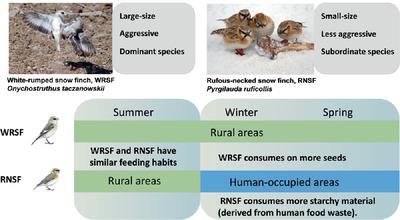当前位置:
X-MOL 学术
›
Integr. Zool.
›
论文详情
Our official English website, www.x-mol.net, welcomes your feedback! (Note: you will need to create a separate account there.)
Coping with extremes: convergences of habitat use, territoriality, and diet in summer but divergences in winter between two sympatric snow finches on the Qinghai-Tibet Plateau.
Integrative Zoology ( IF 3.3 ) Pub Date : 2020-07-06 , DOI: 10.1111/1749-4877.12462 Dongming Li 1, 2, 3 , Jason E Davis 4 , Yanfeng Sun 5 , Gang Wang 3 , Ghulam Nabi 1 , John C Wingfield 3 , Fumin Lei 2, 6, 7
Integrative Zoology ( IF 3.3 ) Pub Date : 2020-07-06 , DOI: 10.1111/1749-4877.12462 Dongming Li 1, 2, 3 , Jason E Davis 4 , Yanfeng Sun 5 , Gang Wang 3 , Ghulam Nabi 1 , John C Wingfield 3 , Fumin Lei 2, 6, 7
Affiliation

|
On the Qinghai‐Tibet Plateau, extreme environmental conditions have imposed intense selective pressure on the evolution of phenotypic traits of wild animals. To date, limited information is available on behavioral and ecological traits concerning niche differentiation among sympatric animals on the Qinghai‐Tibet Plateau, especially during winter when the environments are most severe. Here, we studied the seasonal variations in habitat occurrence, territorial behavior, and diet in two sympatric snow finches (the white‐rumped snow finch, Onychostruthus taczanowskii, WRSF; and the rufous‐necked snow finch, Pyrgilauda ruficollis, RNSF) to determine convergence and divergence of ecological traits in such severe climatic conditions. Our results showed that: (i) WRSF occupied rural areas as a dominant species throughout the annual cycle while RNSF occupied the rural areas in summer and then shifted to human‐occupied areas in winter and spring; (ii) WRSFs exhibited robust aggressive behavior and territoriality during winter relative to RNSFs; (iii) the diets of both species varied with the season but did not vary between species except that WRSF ate significantly more seeds but RNSF consumed more starchy material derived from human food waste during winter. Therefore, the separations in the spatial niche and territoriality between WRSF and RNSF, especially in winter, may contribute to alleviating the pressure of interspecific competition, and promoting the coexistence of the two sympatric snow finches in the extreme environments on the Qinghai‐Tibet Plateau.
中文翻译:

应对极端情况:青藏高原上的两个同伴雪雀在夏季的栖息地使用,地域和饮食趋于一致,而冬季则有所分歧。
在青藏高原,极端的环境条件对野生动物表型性状的演变施加了强烈的选择压力。迄今为止,关于青藏高原同伴动物之间生态位分化的行为和生态特征的信息很少,特别是在环境最严峻的冬季。在这里,我们研究了两个同伴雪雀(白腰雀科,Onychostruthus taczanowskii,WRSF和红颈雀科,Pyrgilauda ruficollis(RNSF)来确定在这种恶劣气候条件下生态特征的趋同和趋异。我们的研究结果表明:(i)WRSF在整个年周期中以农村占主导地位,而RNSF在夏季占农村,然后在冬季和春季转移到人为居住区;(ii)相对于RNSF,WRSF在冬季表现出强大的侵略行为和地域性;(iii)这两种物种的饮食随季节而变化,但不同物种之间没有变化,除了WRSF吃得多的种子,而RNSF在冬季消耗了更多来自人类食物垃圾的淀粉质物质。因此,WRSF和RNSF之间的空间生态位和地域性的分隔,尤其是在冬季,可能有助于减轻种间竞争的压力,
更新日期:2020-07-06
中文翻译:

应对极端情况:青藏高原上的两个同伴雪雀在夏季的栖息地使用,地域和饮食趋于一致,而冬季则有所分歧。
在青藏高原,极端的环境条件对野生动物表型性状的演变施加了强烈的选择压力。迄今为止,关于青藏高原同伴动物之间生态位分化的行为和生态特征的信息很少,特别是在环境最严峻的冬季。在这里,我们研究了两个同伴雪雀(白腰雀科,Onychostruthus taczanowskii,WRSF和红颈雀科,Pyrgilauda ruficollis(RNSF)来确定在这种恶劣气候条件下生态特征的趋同和趋异。我们的研究结果表明:(i)WRSF在整个年周期中以农村占主导地位,而RNSF在夏季占农村,然后在冬季和春季转移到人为居住区;(ii)相对于RNSF,WRSF在冬季表现出强大的侵略行为和地域性;(iii)这两种物种的饮食随季节而变化,但不同物种之间没有变化,除了WRSF吃得多的种子,而RNSF在冬季消耗了更多来自人类食物垃圾的淀粉质物质。因此,WRSF和RNSF之间的空间生态位和地域性的分隔,尤其是在冬季,可能有助于减轻种间竞争的压力,



























 京公网安备 11010802027423号
京公网安备 11010802027423号